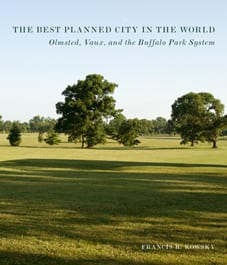MEDIA KIT: Best Planned City in the World

Moving Earth to Create Heaven
The Best Planned City in the World Looks at the Rise of the Revolutionary Buffalo Park System
It’s hard to imagine the world’s major cities without their public parks. The greatest examples, such as London’s Hyde Park, the Tuileries Garden in Paris, and Central Park in New York City, are defining aspects of the urban experience.
It wasn’t always so, as Francis R. Kowsky shows in his new history, The Best Planned City in the World. Until the 1850s, the concept of a “pastoral environment in the heart of the city available to all classes of society” simply didn’t exist. The movement for healthy verdant spaces open to all citizens required visionary men. In 1868 two of them, Fredrick Law Olmsted and Calvert Vaux, set their sights on Buffalo, New York. Their goal: to create nothing less than the most extensive park system in the world.
The Queen City of the Lakes has seen better days. But its park system, built during the city’s economic and cultural ascendancy, is still recognized for its magnificent innovations in the art of urban planning and landscape design. “Professor Kowsky does a wonderful job of illuminating the thinking of the major players in the saga,” says Robin Karson executive director of The Library of American Landscape History (LALH), the foremost publisher in the field of American landscape history. The Best Planned City in the World is the first book in the LALH Designing the American Park series, written by leading historians in the field. “Scholarship is important in preserving our natural landscapes,” adds Karson. “When people understand the careful planning that went into the parks they’re getting to enjoy today, they tend to value them more and take better care of them.”
Democracy in dirt and trees
Buffalo’s park system was to be the first of its kind, a revolutionary urban experiment worthy of what was then one of the busiest ports on earth in all its Gilded Age glory. For Olmsted and Vaux, straight off their twin triumphs Central and Prospect Parks, one park for Buffalo wasn’t enough. Buffalo was to have three parks distinct from one another, linked throughout the city by majestic, tree-canopied boulevards (“parkways,” Olmsted called them) that were parks in themselves. It was, and remains, the first metropolitan park system of its kind planned, as Kowsky reminds us, down to the smallest detail. Olmsted and Vaux ordered thousands of trees and hundreds of varieties of shrubs and plants as well as sheep to graze the meadow, just to make sure that everything would be perfect.
The metropolitan park movement—which, along with a few forebears, Olmsted and Vaux essentially created—is utopian in its scope. Olmsted and Vaux weren’t simply creating landscapes (though they did that exquisitely as shown in the book’s wonderful photographs) as much as creating urban amenities that significantly raised the quality of life in America’s cities. They were “enabling people of all backgrounds,” not just those who could afford it, to congregate “in pure air and under the light of heaven” free from the constraints of the “ordinary hard, hustling working hours of town life.” Olmsted, who would return to Buffalo many times in the 1880s and 1890s to plan additional parkland, called it “democracy in dirt and trees.” He expected all of his public parks to promote the moral and social well-being of the diverse nation.
As a work of scholarship, The Best Planned City in the World is comprehensive. Kowsky, of course, recognizes that public projects of the scope of the Buffalo parks system are never divorced from real-world concerns. It took many years for Olmsted’s landscapes to grow to maturity. There were bumps along the way—political and budgetary—but Professor Kowsky has succeeded in balancing philosophical perspective with substantive detail. The blend makes for a richer understanding of how the Western world got some of its greatest parks, including Niagara Falls State Park, the creation of which the author narrates as part of Olmsted’s Buffalo saga.
Suggested questions for interviewers
1. What’s the state of municipal park development today? Where are the most innovative new parks being built?
2. What effects have budget cuts had on large city parks around the country?
3. What accounted for Olmsted and Vaux’s success? Was it talent? Vision? Or being in the right place at the right time in history?
4. Why did Olmsted and Vaux end their partnership?
5. How much would it cost to create Olmsted’s Buffalo’s park system in today’s dollars?
6. What do you see as the purpose of a park today?
The Best Planned City in the World: Olmsted, Vaux, and the Buffalo Park System
By Francis R. Kowsky
Published by University of Massachusetts Press in association with LALH
272 pp., 8.5 x 10, 118 color illus., 110 b & w illus.
$39.95 cloth, ISBN 978-1-62534-006-1
For further information, visit https://lalh.org/best-planned-city-in-the-world
Francis R. Kowsky is a SUNY Distinguished Professor Emeritus. In addition to The Best Planned City in the World, he has written Country, Park and City: The Architecture and Life of Calvert Vaux. Professor Kowsky is a Fellow of the Society of Architectural Historians.
The Library of American Landscape History’s mission is to foster understanding of the fine art of landscape architecture and appreciation for North America’s richly varied landscape heritage through LALH books, exhibitions, and online resources. Founded in 1992, LALH is the only nonprofit organization in the world devoted to publishing in the field of American landscape history. LALH books are informative, engaging, and priced affordably, thanks to the generous gifts of its supporters.
Media contact: Victor Gulotta
Gulotta Communications, Inc.
617-630-9286
http://www.booktours.com
victor(at)booktours(dot)com